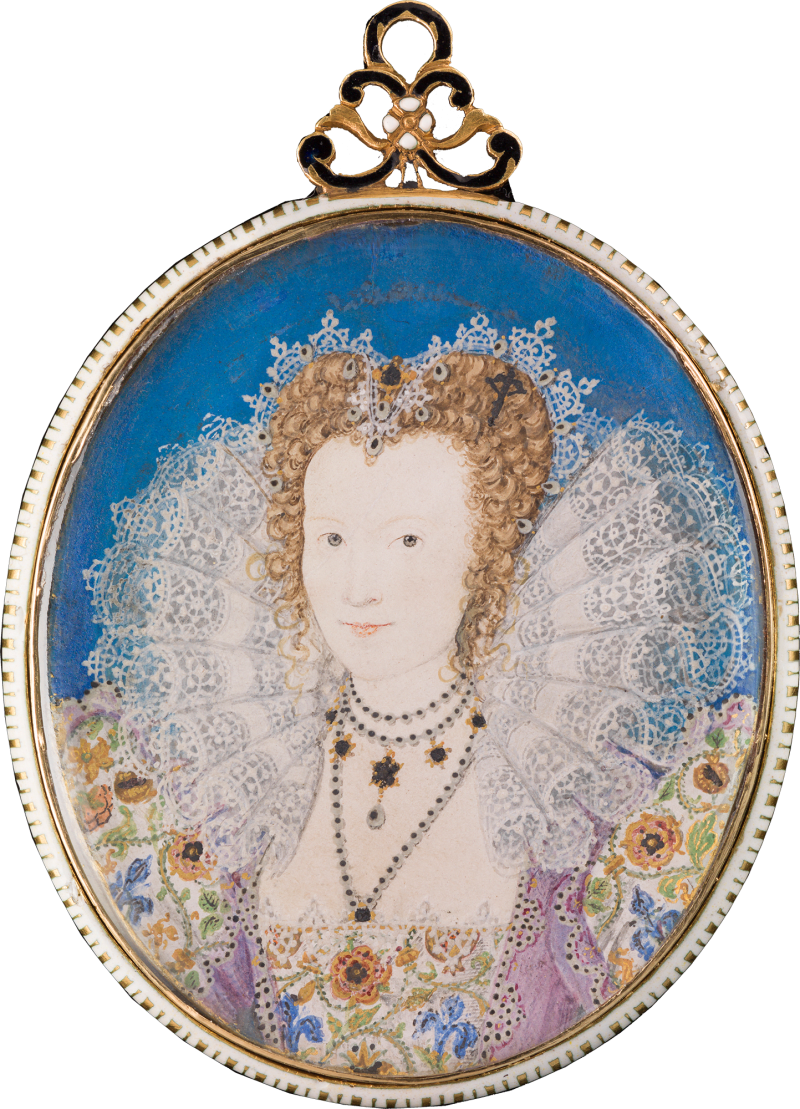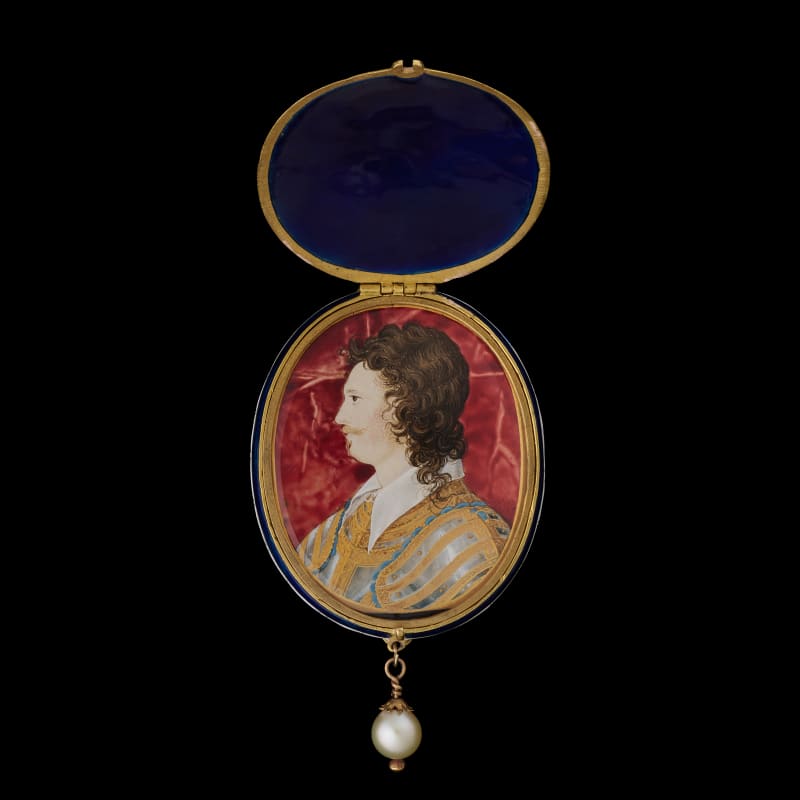Sold out
Writing in the 1940s, Carl Winter foretold that ‘The fragmentary story of Elizabethan Limning has to be pieced together round the career of Hillyarde’.[1] His words remain true today, with Elizabeth Goldring, Nicholas Hilliard’s most recent biographer, finding room for a scrupulous re-examination of not only his artistic development but also his personal story.[2] This holistic approach has brought to life the enigmatic artist, detailing every known aspect of his existence and how it was intertwined with those of his sitters, both inside and outside the court of Elizabeth I.
This portrait of a young man with distinctive pale blond hair was painted during the last ten years of Elizabeth’s reign. By this date, Hilliard had been working professionally for around twenty years, fashioning the image of the queen and those who surrounded her.[3] His finances were never stable – a perennial defaulter on endless loans, he was not awarded the traditional pension of court artists before him...
This portrait of a young man with distinctive pale blond hair was painted during the last ten years of Elizabeth’s reign. By this date, Hilliard had been working professionally for around twenty years, fashioning the image of the queen and those who surrounded her.[3] His finances were never stable – a perennial defaulter on endless loans, he was not awarded the traditional pension of court artists before him...
| Writing in the 1940s, Carl Winter foretold that ‘The fragmentary story of Elizabethan Limning has to be pieced together round the career of Hillyarde’.[1] His words remain true today, with Elizabeth Goldring, Nicholas Hilliard’s most recent biographer, finding room for a scrupulous re-examination of not only his artistic development but also his personal story.[2] This holistic approach has brought to life the enigmatic artist, detailing every known aspect of his existence and how it was intertwined with those of his sitters, both inside and outside the court of Elizabeth I. This portrait of a young man with distinctive pale blond hair was painted during the last ten years of Elizabeth’s reign. By this date, Hilliard had been working professionally for around twenty years, fashioning the image of the queen and those who surrounded her.[3] His finances were never stable – a perennial defaulter on endless loans, he was not awarded the traditional pension of court artists before him until late in life. This forced him to look outside the court for commissions, as in Hilliard’s own words, these were ‘more proffitable’.[4] Painting anyone who could afford him may have occasionally injured Hilliard’s pride, but it has left later historians with a rich insight into the wealthy individuals who operated outside aristocratic circles and the court and how they appeared. As Goldring has pointed out, those who could pay to sit for Hilliard still had to be extremely prosperous individuals, even if they were yet to be titled.[5] So what clues exist within this portrait as to the status of the sitter? Certainly one outstanding feature is his pink doublet, which would have made the sitter particularly conspicuous, especially in a sea of black and white clothing which were Queen Elizabeth’s favoured colours. A painting from circa 1600 by an unknown Netherlandish artist shows Elizabeth carried by her male courtiers, three of whom are wearing pink doublet and hose.[6] Although it is only possible to speculate, the sitter in this portrait, with his neatly trimmed beard and outré dress seems to belong to the group of men painted by both Hilliard and Isaac Oliver in this period, who were more the aristocratic adventurer type than the contemplative thinker. This group includes Hilliard’s portraits of George Clifford, 3rd Earl of Cumberland, Sir Anthony Mildmay, Sir Robert Dudley, and Henry Percy, 9th Earl of Northumberland. Even the slightly earlier portrait of 1585 of Sir Walter Ralegh has the same raffish mood. Isaac Oliver’s self portrait of circa 1590 can be said to exude a comparable self-confidence, with the artist showing himself with his hand on hip to flaunt a showy red leather glove and his gaze boldly holding that of the viewer. Finally, the face and distinctive blond hair of the sitter are close to those of an unknown gentleman portrayed by Hilliard in an allegorical portrait, which shows him clasping a hand that descends from a cloud above. Hilliard was continually evolving as an artist, but here he remains faithful to what had always been a winning formula. The sitter’s face, with its clear complexion, is drawn with what Hilliard referred to as ‘the truth of the line’, with the result being an honest, open face and a direct gaze. Hilliard’s sense of artistic balance is brilliantly conveyed in this portrait, with the sitter’s swept-back blond hair and unadorned ears skilfully offset by his deep pink doublet, every stitch recorded, below a lace-trimmed collar of white gauze.[7] It was at this date that Hilliard was also experimenting with backgrounds. Although the sitter here is shown against a traditional bright blue background, an example of Hilliard’s work from this period shows the sitter against a plain black backdrop.[8] The clear, bright blue background shown here was a continuation of the quality that patrons expected from the experienced hand of Hilliard. The brilliance of these blue backgrounds was difficult to achieve. Azurite, the main pigment that was used, was coarse and difficult to work with. In order to attain the intense colours that can be seen here, layers of watercolour needed to be carefully “floated” atop one another. The technique was one that only a few artists could master. Yet, focussing attention on the sitter’s face with disarming simplicity, it had an enduring popularity, which stretched into the first decades of the next century. [1] Winter, C. (1943) Elizabethan Miniatures. London: Penguin, p. 5. [2] Goldring, E. (2019) Nicholas Hilliard: Life of an Artist. New Haven and London: Yale University Press. [3] Hilliard’s first known adult miniature is dated 1571, when his sitter was A Man Aged 35 (private collection); the next, dated 1572 (Victoria and Albert Museum). Edward Town has recently proposed an earlier portrait of Elizabeth I by Hilliard which he dates to 1571, see: Town, E. (2020) ‘A Portrait of the Miniaturist as a Young Man: Nicholas Hilliard and the Painters of 1560s London’, British Art Studies, [online] Issue 17. Available at: https://britishartstudies.ac.u... [Accessed 5 Jan. 2021]. [4] Hilliard, N. quoted in Thornton, R. K. R. and Cain, T. G. S. (eds.), Nicholas Hilliard: The Arte of Limning. 2nd edn. Manchester: Carcanet Press, p. 69. [5] Hilliard charged £3 for his portraits – a huge sum three times the annual wage of a manual labourer, see: Goldring, (2019) Hilliard, p. 199. [6] Sherborne Castle, Dorset. [7] A later portrait of a similarly coloured doublet worn by Sir John Renruddock (circa 1619-20) shows it matched with pink hose, which must have made a striking sartorial statement. Sold Christie’s, London, 2 March 2014, lot 5. [8] See the portrait of an unknown young man in the Victoria and Albert Museum, London, P.3–1974. |





